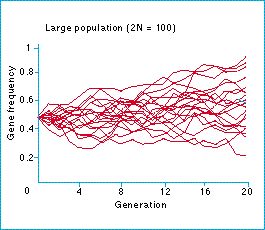Neutral evolution

In neutral evolution many of the changes that occur during evolution are selectively neutral.
The frequency of a selectively neutral gene is as likely to decrease as to increase by genetic drift; on average the frequencies of neutral alleles remain unchanged from one generation to the next.
In practice, their frequencies drift up and down, and it is therefore possible for a gene to enjoy a run of luck and be carried up to a much higher frequency - in the extreme case, its frequency could after many generations be carried up to 1 (become fixed) by random drift.
Genetic drift at the molecular level has given rise to the neutral theory of molecular evolution.
What is the rate of neutral evolution?
Figure: twenty repeat simulations of genetic drift for a two-allele locus with initial gene frequency 0.5. Eventually one of the alleles (which is selectively neutral) drifts to a frequency of one: this is through neutral evolution.
| Next |



